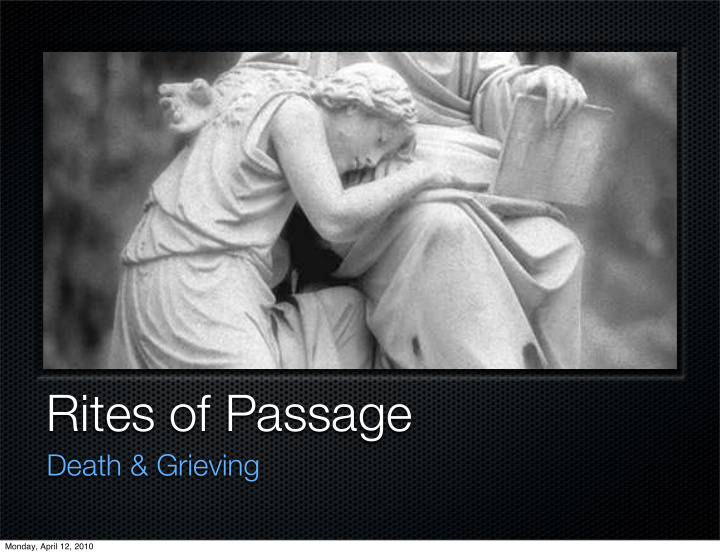



Rites of Passage Death & Grieving Monday, April 12, 2010
Death as a Rite of Passage In many ways Death is the most significant Rite of Passage. Humans have always faced it and never escaped it. Happens to everyone, it is inevitable. Religion & Culture affect how we view Death. Monday, April 12, 2010
Every society has complex explanations surrounding Death What causes it What happens to the body and spirit of the deceased What traditions are observed to ensure that he reaches the next life properly. Monday, April 12, 2010
Ancient Egypt Mummification Canopic Jars The Book of the Dead Monday, April 12, 2010
The Irish Wake Stop the Clocks and Open a Window Watch over the Body Keening Monday, April 12, 2010
Navy Burial at Sea Family is NOT aboard the ship Burial Flag is returned to the family Monday, April 12, 2010
New Orleans Jazz Funeral Procession followed by Band “Cutting the body loose” The Second Line dancers join in waving handkerchiefs Monday, April 12, 2010
Adowa The Funeral Dance of Ghana Monday, April 12, 2010
The Afterlife Judaism, Christianity, and Islam. Monday, April 12, 2010
A bridge or journey Such as the Greek belief in the River Styx Monday, April 12, 2010
Funeral Customs adapted from Ancient Times: Monday, April 12, 2010
Funeral Customs Feasting and Gatherings: food offerings The Wake: watching over the body Lighting of Candles: protecting the living from spirits Flowers: offerings to please the deceased’s spirit Music: chants to placate the spirits Clothing: used to disguise one’s identity from the spirits Rifle Volley: tribal spears thrown to ward off hovering spirits Ringing Bells: ward off spirits Monday, April 12, 2010
Grieving Monday, April 12, 2010
Kubler-Ross Model of Grief Monday, April 12, 2010
The Grief Cycle also applies to the Bereaved. This cycle describes the stages of bereavement a person goes through upon the death of a family member or close friend. Monday, April 12, 2010
The Grief Cycle Shock Recovery Denial Mourning Anger Monday, April 12, 2010
Recommend
More recommend